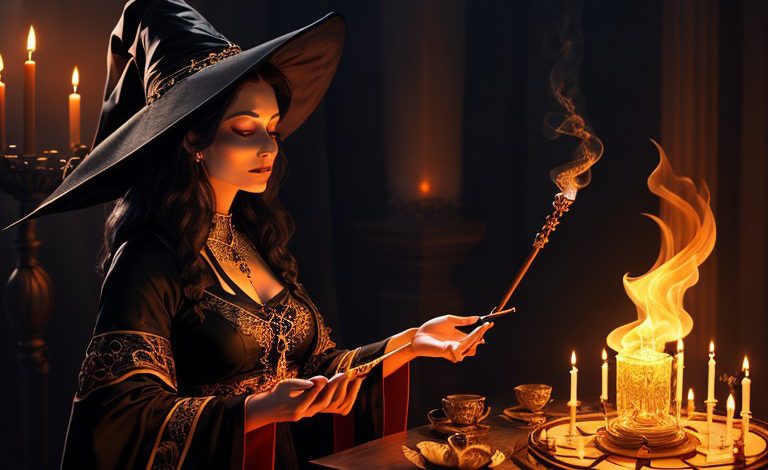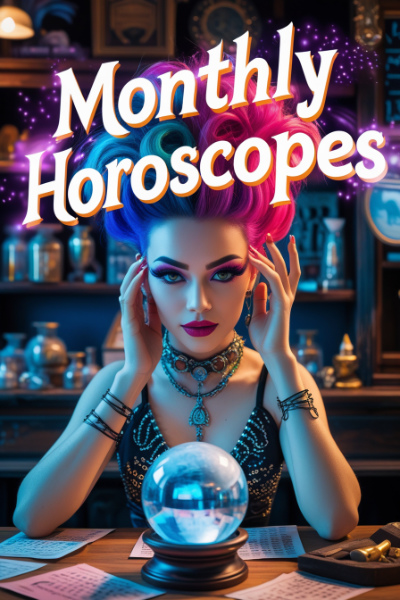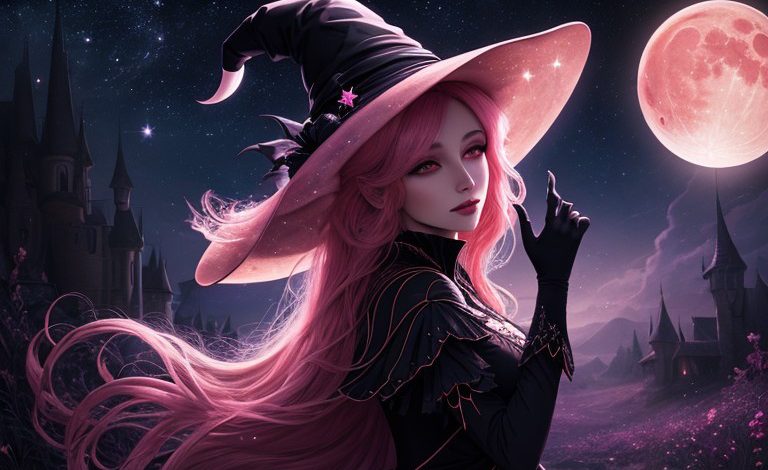
As the luminous Pink Moon graces the night sky, Pagans around the world gather to celebrate the shifting of seasons and the interconnectedness of life. This enchanting lunar event holds special significance in Pagan traditions, symbolizing renewal, growth, and the cyclical nature of existence. Just as the moon waxes and wanes, so too do the rhythms of nature and the rhythms of our lives. The Pink Moon is a reminder of the ever-turning wheel of time and the continuous journey of our souls.
Under the Pink Moon’s gentle glow, Pagans engage in rituals that honor the Earth’s fertility and the energies of rebirth. It’s a time for planting seeds, both metaphorically and literally, as the earth awakens from its winter slumber. Bonfires are lit, illuminating the darkness and creating a sacred space for meditation, reflection, and communing with the elements. As the moon’s rosy hues touch the landscape, Pagans find themselves inspired to embrace change, let go of the old, and welcome the new with open hearts. The Pink Moon for Pagans is a tapestry woven with threads of mysticism, unity with nature, and the promise of transformation.
What is the Pink Moon ?

The Pink Moon, while not actually pink in color, refers to the full moon that typically appears in April. This name originates from the vibrant pink wildflowers, known as wild ground phlox, that bloom during this time of year. For Pagans, the Pink Moon embodies a profound symbol of renewal and growth. Its arrival marks a juncture where the natural world transitions from the dormancy of winter to the vitality of spring. Pagans see this celestial event as a reminder of life’s cyclical nature, emphasizing themes of rebirth and transformation. During this period, Pagans often engage in rituals that honor the Earth’s fertility, focusing on planting seeds both metaphorically and literally, and connecting with the energies of rejuvenation and the ever-changing rhythms of existence.
The Pink Moon’s Message

The Pink Moon, despite its name, does not radiate a rosy hue but instead signifies a powerful message that resonates with those who observe it. This full moon, typically appearing in April, has garnered symbolic significance across various cultures, each interpreting its message in unique ways. One common thread that runs through these interpretations is the notion of renewal and growth. The name “Pink Moon” originates from the pink wildflowers, such as wild ground phlox, that bloom during this season. This vibrant burst of color amid nature’s awakening serves as a reminder that even in the most dormant of times, there is the potential for life to flourish.
For Pagans, the Pink Moon holds particular importance as a symbol of cyclical transformation. It represents the moment when the natural world transitions from the stillness of winter to the vibrancy of spring. In Pagan traditions, this lunar event signifies rebirth and renewal, prompting individuals to contemplate their own cycles of growth and change. It encourages the planting of metaphorical seeds, such as setting intentions and embarking on new ventures, mirroring the Earth’s readiness to nurture new life. The Pink Moon serves as a beacon, guiding Pagans to embrace change and acknowledge the ever-turning wheel of life.
In broader cultural contexts, the Pink Moon’s message is one of hope and optimism. As it graces the night sky, it illuminates the darkness and inspires us to see beyond challenging times. It encourages us to let go of the past, symbolized by the fading moonlight of the previous phases, and to welcome the future with open arms. In essence, the Pink Moon conveys the idea that even in the darkest of moments, there is a promise of light, growth, and transformation. It is a celestial reminder that life is a continuous journey, and with each passing phase, there is an opportunity for renewal and evolution.
Magic Under the Pink Moon

The Pink Moon, with its soft, ethereal glow, has long been regarded as a powerful backdrop for magic and mystical practices. As it graces the night sky, it evokes a sense of wonder and reverence, inviting practitioners of various spiritual paths to harness its energies for a range of magical endeavors.
For many, the Pink Moon represents a time of transformation and renewal. Its presence in the heavens signifies the transition from the dormancy of winter to the vitality of spring. This natural shift mirrors the transformative potential within ourselves. As such, the Pink Moon is seen as a favorable moment for setting intentions, letting go of the old, and embracing personal growth.
Under the Pink Moon’s luminous light, rituals and spells focused on personal development, self-discovery, and manifestation are particularly potent. Practitioners might gather in sacred circles, light candles, and call upon the moon’s energy to amplify their intentions. Whether it’s a desire for healing, a quest for wisdom, or the pursuit of love, the Pink Moon is believed to enhance the power of intention-setting.
In some magical traditions, the Pink Moon is also associated with love and fertility. It’s seen as a time when the energies of romance and passion are heightened. Couples may perform love spells or engage in rituals that strengthen their emotional bonds. For those seeking to conceive, the Pink Moon is considered an auspicious time to invoke the energies of fertility.
In essence, magic under the Pink Moon is a celebration of the interconnectedness between the natural world and our spiritual selves. It’s a time to honor the cycles of life, embrace change, and tap into the energies of renewal and growth. Whether you practice magic or simply gaze at the Pink Moon in awe, its presence in the night sky serves as a reminder of the enchantment and mystery that surround us, inviting us to explore the realms of the unknown and discover the magic within ourselves.
Cultural Celebrations
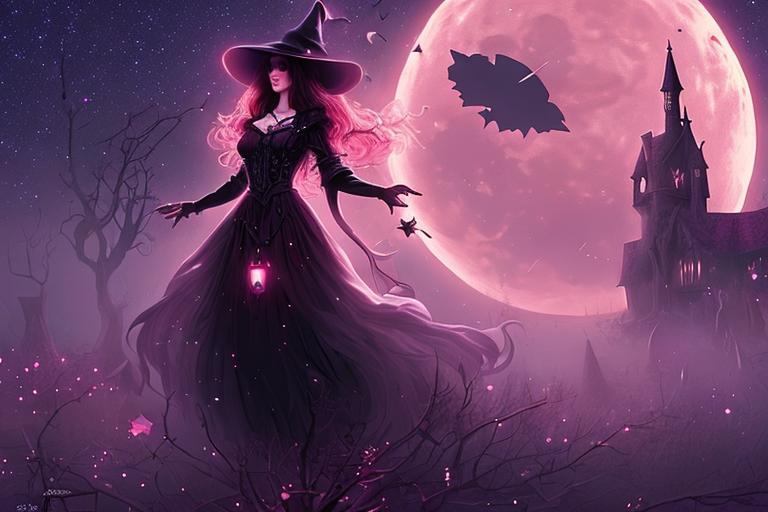
The Pink Moon’s allure transcends geographic boundaries, inspiring diverse cultures around the world to celebrate its arrival with unique rituals and traditions. While the Pink Moon isn’t always referred to as such in every culture, its significance as a harbinger of spring and renewal is universally recognized. Here’s a glimpse into how different cultures celebrate this captivating lunar event:
Pagan Traditions: For Pagans, the Pink Moon holds particular importance as a symbol of cyclical transformation. It represents the moment when the natural world transitions from the stillness of winter to the vibrancy of spring. In Pagan traditions, this lunar event signifies rebirth and renewal, prompting individuals to contemplate their own cycles of growth and change. It encourages the planting of metaphorical seeds, such as setting intentions and embarking on new ventures, mirroring the Earth’s readiness to nurture new life. The Pink Moon serves as a beacon, guiding Pagans to embrace change and acknowledge the ever-turning wheel of life.
Moon Goddesses: Across various cultures, the moon is often personified as a goddess, and the Pink Moon is no exception. It’s seen as a time when lunar goddesses, such as Selene or Luna, are believed to be at their most powerful, influencing the natural world and human emotions.
Hare Moon: In some European traditions, the Pink Moon is alternatively known as the “Hare Moon.” This name stems from the idea that April is the breeding season for hares, and sightings of hares dancing under the full moon became associated with this time. Hares have also been tied to moon deities in various cultures, adding a mystical dimension to the Pink Moon’s folklore.
Native American Tribes: Several Native American tribes in North America refer to the April full moon as the “Pink Moon” in honor of the pink wildflowers that bloom during this time. Among them, the Algonquian tribes are particularly known for this naming tradition. For these tribes, the Pink Moon signifies the return of spring and the emergence of new life. Rituals often involve communal gatherings, storytelling, and dances that celebrate the Earth’s awakening.
Buddhism: In some Buddhist cultures, April’s full moon marks the observance of Vesak, also known as Buddha Purnima. This sacred day commemorates the birth, enlightenment, and death (parinirvana) of Gautama Buddha. Buddhists participate in candlelit processions, visit temples to offer flowers and prayers, and engage in acts of kindness and generosity as a way to honor the Buddha’s teachings.
Hinduism: The Pink Moon is associated with Hanuman Jayanti, a Hindu festival dedicated to Lord Hanuman, a revered deity in Hindu mythology. Devotees gather at temples to recite Hanuman Chalisa (a devotional hymn), perform pujas (ritual offerings), and participate in spiritual discourses. The Pink Moon’s brightness is believed to symbolize Hanuman’s unwavering devotion and strength.
Japanese Cherry Blossom Festivals: In Japan, the Pink Moon coincides with the blooming of cherry blossoms, known as “sakura.” This breathtaking natural spectacle inspires the annual Hanami festivals, where people gather beneath cherry blossom trees to appreciate their beauty. Picnics, music, and dance are common features of these celebrations, highlighting the transient nature of life and the beauty of impermanence.
Christianity: In Western Christianity, the Pink Moon aligns with the Easter season, a time commemorating the resurrection of Jesus Christ. While Easter itself does not revolve around the moon, its date is determined by the lunar cycle, often falling close to the Pink Moon. Christians mark this occasion with church services, egg hunts, and festive meals.
These cultural celebrations illustrate the Pink Moon’s ability to foster a sense of interconnectedness between humanity and the natural world, bridging diverse traditions through the shared appreciation of renewal and growth during this enchanting lunar phase.
Astrological Significance
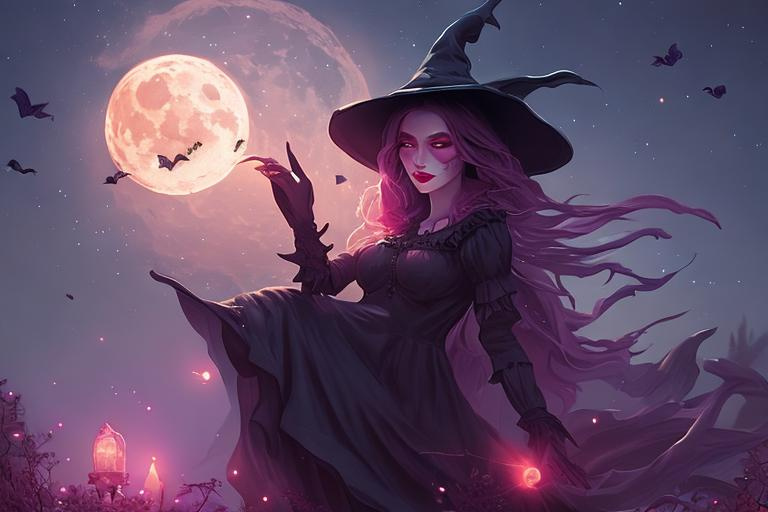
For astrology enthusiasts, the Pink Moon holds a unique place in the celestial calendar, offering a window into the cosmic energies and their potential impact on our lives. The Pink Moon’s position in the zodiac and its astrological aspects can provide valuable insights into what this lunar phase signifies in various astrological traditions.
Zodiac Position: The astrological significance of the Pink Moon depends on its position in the zodiac. As the Pink Moon typically occurs in April, it falls under the sign of Aries, the first sign of the zodiac. Aries is associated with attributes such as initiative, leadership, and a pioneering spirit. Therefore, the Pink Moon in Aries often signifies a time of new beginnings, assertiveness, and a surge of energy, making it an auspicious period for taking action and pursuing personal goals.
Energetic Impact: Astrologers believe that the Pink Moon’s energy can influence our emotions, behaviors, and experiences. It’s often seen as a time when emotions run high, and individuals may feel a surge of motivation and enthusiasm. However, this heightened energy can also bring challenges, such as impulsiveness or impatience. Astrologers advise using this energy consciously to set intentions and work towards personal growth.
Vedic Astrology: In Vedic astrology, the Pink Moon’s significance is linked to the lunar mansion, or Nakshatra, in which it falls. Depending on the year and its position, it may correspond to different Nakshatras, each carrying its own unique energies and themes. Vedic astrologers analyze these Nakshatras to offer insights into how the Pink Moon might influence an individual’s life, relationships, and overall well-being.
Planetary Aspects: Astrologers also consider the planetary aspects that coincide with the Pink Moon. The positions of the planets at this time can enhance or temper its effects. For example, if the Pink Moon forms harmonious aspects with benefic planets like Venus or Jupiter, it can indicate a period of ease and abundance. Conversely, challenging aspects with malefic planets like Saturn or Mars may suggest obstacles or conflict to be navigated.
Personal Reflection and Intentions: Astrology enthusiasts often use the Pink Moon as a moment for personal reflection and intention-setting. They may consult their birth charts to understand how this lunar phase aligns with their individual astrological profiles. This introspective process can guide them in setting meaningful intentions and aligning their actions with the prevailing cosmic energies.
The Pink Moon carries astrological significance that resonates with astrology enthusiasts in various traditions. Its position in the zodiac, energetic impact, and alignment with planetary aspects provide valuable insights into the themes and opportunities of this lunar phase. Whether it’s a time for taking bold steps, setting intentions, or navigating cosmic influences, the Pink Moon invites astrology enthusiasts to engage with the cosmos on a deeper level and embrace the transformative potential of the night sky.
The Pink Moon’s Connection to the Divine Feminine
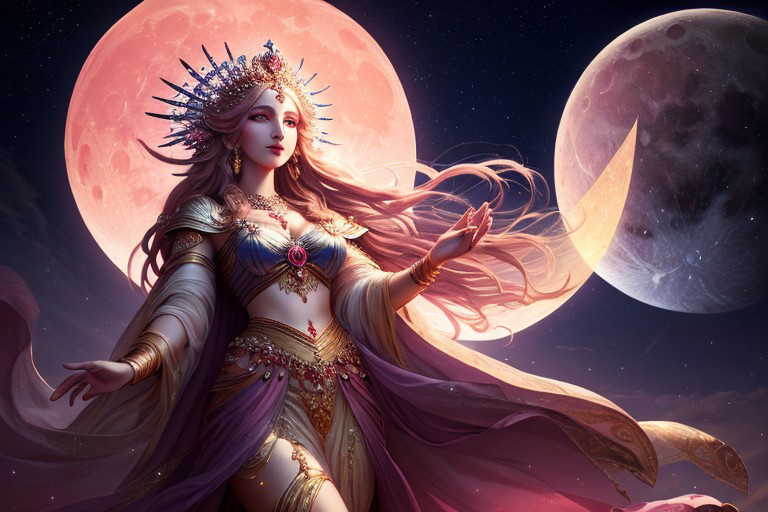
The Pink Moon, though not colored pink itself, carries a deep and enduring connection to the concept of the Divine Feminine across various cultures and spiritual traditions. This association is not only rooted in the moon’s cycles but also in the profound symbolism it embodies. The Pink Moon’s celestial presence is often seen as a reflection of the feminine energies that permeate the universe, nurturing, intuitive, and cyclical in nature.
In many cultures, the moon has long been personified as a goddess, representing the nurturing and cyclical aspects of life. The Pink Moon, specifically, aligns with these goddess archetypes. It symbolizes the transition from the stillness of winter to the vibrant growth of spring, mirroring the cycles of life, death, and rebirth. This metamorphosis is reminiscent of the phases of the moon itself, where it waxes and wanes, offering a powerful allegory for the ebb and flow of existence.
For Pagans and those who follow Earth-based spiritual paths, the Pink Moon is a time when the Goddess, often personified as Mother Earth, awakens from her slumber. It’s a moment when her creative and nurturing energies surge forth, inviting all living beings to participate in the dance of life. Rituals and ceremonies during this time often focus on honoring and connecting with the Divine Feminine, acknowledging her role as a source of inspiration, wisdom, and renewal. In this way, the Pink Moon becomes a sacred bridge between the earthly and spiritual realms, a reminder of the enduring presence of the Divine Feminine in our lives.
The Pink Moon’s connection to the Divine Feminine serves as a potent reminder of the importance of balance and harmony in the universe. It encourages us to embrace the qualities of nurturing, intuition, and interconnectedness, not only in our relationship with the natural world but also within ourselves. The Pink Moon invites us to celebrate the feminine aspects of both the cosmos and our own beings, fostering a deeper understanding of the cyclical nature of existence and the profound interconnectedness between all living things.
Upcoming Pink Moon Dates:
For those eager to witness the enchanting Pink Moon and partake in the celestial festivities it inspires, here is a list of future Pink Moon dates to mark on your calendars:
April 16, 2024: The Pink Moon will grace the night sky, ushering in the beauty of spring and renewal.
April 5, 2025: Don’t miss the Pink Moon’s radiant glow as it illuminates the world, signaling the changing of seasons.
April 25, 2026: The Pink Moon returns, offering its message of growth and transformation under the night’s celestial canopy.
April 14, 2027: Prepare to celebrate the Pink Moon once again, as it reminds us of life’s ever-revolving cycles.
April 3, 2028: The Pink Moon emerges, inviting us to embrace change and the promise of new beginnings.
These upcoming Pink Moon dates provide perfect opportunities to connect with the natural world, engage in meaningful rituals, or simply gaze at the night sky in wonder as we continue to honor the eternal dance of the moon and the seasons.


